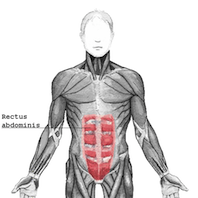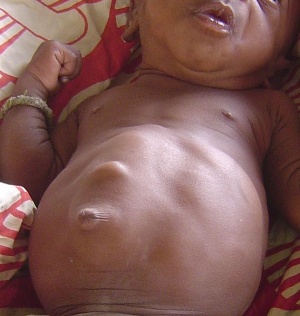Diastasis Recti Abdominis
Original Editor - Marianne Ryan
Top Contributors - Nicole Hills, Sivapriya Ramakrishnan, Lucinda hampton, Admin, Vidya Acharya, Victoria Geropoulos, Regan Haley, Rachael Lowe, Laura Ritchie, Marianne Ryan, Oyemi Sillo, Kim Jackson, Michelle Walsh, WikiSysop, Tarina van der Stockt and Claire Knott - Your name will be added here if you are a lead editor on this page.
Description[edit | edit source]
Diastasis recti (also known as abdominal separation) is a disorder defined as a separation of the rectus abdominis muscle into right and left halves.
Clinically Relevant Anatomy
[edit | edit source]
Normally, the two sides of the Rectus Abdominis are joined at the linea alba at the body midline.
Mechanism of Injury / Pathological Process
[edit | edit source]
Diastasis of this muscle occurs principally in two populations: newborns and pregnant women.
- In the newborn, the rectus abdominis is not fully developed and may not be sealed together at midline. Diastasis recti is more common in premature and black newborns.
- In pregnant or postpartum women, the defect is caused by the stretching of the rectus abdominis by the growing uterus. It is more common in multiparous women due to repeated episodes of stretching. When the defect occurs during pregnancy, the uterus can sometimes be seen bulging through the abdominal wall beneath the skin.
Clinical Presentation[edit | edit source]
| [1] |
Diagnostic Procedures[edit | edit source]
add text here relating to diagnostic tests for the condition
Outcome Measures[edit | edit source]
add links to outcome measures here (see Outcome Measures Database)
Management / Interventions
[edit | edit source]
Abdominal Binders[edit | edit source]
Binders do have a place in the treatment of the condition, but the wrong or overuse of them can cause more problems. It is best not to use an abdominal binder unless absolutely necessary, for example during pregnancy in the third trimester and 6 weeks after delivery if there is a separation of 2 fingers or more.
Belly Band[edit | edit source]
Wearing a belly band during pregnancy (one made specifically for pregnant women) will help increase proprioception and muscle awareness. A belly band or tight tube top can be used after childbirth for the same reasons.
Kegel Exercises[edit | edit source]
Pelvic floor exercises will help strengthen deep abdominal muscles
because all the core muscles contract automatically as a cohesive group. These exercises can be performed through out pregnancy and may be started in the early postpartum period.
Breathing Exercises[edit | edit source]
Breathing exercises help to retrain the diaphragm to relearn how to descend after childbirth. During pregnancy the diaphragm is pushed upwards by the growing uterus and loses its ability to descend during inhalation. Since the diaphragm forms the top of the core muscles, it is important to retrain it to function with a full excursion again. Here are 2 good exercises
- Inverted Breathing - Lie supine with the buttock on a pillow wedge, raised above chest level. Teach patient to take short shallow breaths “through the pelvic diaphragm”. Have patient place one hand just above the pubic symphysis and teach them to feel for a slight up and down motion while they breathe in and out. Place the patients other hand on top of their chest and tell them to try not to have their chest rise when breathing.
- Lateral Costal Breathing - In the seated position have patient place their hands on the lateral sides of the rib cage. Teach them to “breathe into their hands” and to feel for the lateral expansion of the rib cage as they inhale and the movement of the ribcage toward the midline during exhalation.
Progressive Core Exercises[edit | edit source]
There are several exercise that can be used to help restore core strength which will help close the gap in a diastasis. For more detail refer to Diane Lee’s well-published work on the Diastasis Recti. (http://dianelee.ca/education/article_diastasis.php)
| [2] | [3] |
Sit-Ups and Crunches[edit | edit source]
Teach patient not to do sit-ups or other crunches to strengthen the abdominal muscles. Sit-ups and similar exercises put a great deal of strain on the pelvic floor and can cause further separation of the abdominal muscles and should be avoided in the prenatal and post-partum phases.
Body Mechanics[edit | edit source]
It is important to teach patient how to perform ADL’s without increasing abdominal pressure, such as rolling out of bed, instead of doing a “sit-up” to get up. Avoid “jack-knifing” behavior that increases intra-abdominal pressure. Other activities to watch out for is getting out of a bath, lifting and carrying older children and heavy objects during pregnancy and the early postpartum period. Teach them to “exhale as you lift.”
Postural Awareness[edit | edit source]
After pregnancy women tend to stand with and an exaggerated anterior pelvic tilt and with their pelvis pushed forward. In order to stand up against gravity their bodies typically develop areas of rigidity in upper lumbar and lower thoracic area along with the buttock muscles. Diane Lee refers to this as “back clenching and buttock griping behavior.” Manual therapy and relaxation exercises must be used prior to strengthening exercises. (http://dianelee.ca/articles/UnderstandYourBack&PGPopt.pdf)
Differential Diagnosis
[edit | edit source]
add text here relating to the differential diagnosis of this condition
Key Evidence[edit | edit source]
add text here relating to key evidence with regards to any of the above headings
Resources
[edit | edit source]
http://dianelee.ca/courses-conference-presentations.php
| [4] | [5] |
Case Studies[edit | edit source]
add links to case studies here (case studies should be added on new pages using the case study template)
Recent Related Research (from Pubmed)[edit | edit source]
Failed to load RSS feed from http://www.ncbi.nlm.nih.gov/entrez/eutils/erss.cgi?rss_guid=1LgINZmdEb7dTigc1TKL-TXnE05acxicWI5QVuzH8STBOME1S5|charset=UTF-8|short|max=10: Error parsing XML for RSS
References[edit | edit source]
References will automatically be added here, see adding references tutorial.
- ↑ ItsMeMesh. Diastasis Recti. Available from: http://www.youtube.com/watch?v=l_I6JnO3aHw[last accessed 25/05/13]
- ↑ Fit Healthy Moms. 3 Ab Exercises to Heal Diastasis Recti. Available from: http://www.youtube.com/watch?v=Q6SfiH2-TEQ [last accessed 25/05/13]
- ↑ MomsIntoFitness. Diastasis Recti Exercises 5 min Core Workout : DVD. Available from: http://www.youtube.com/watch?v=6mpd3EVRaO4 [last accessed 25/05/13]
- ↑ Diane Lee. Integrated Systems Model for Physiotherapy in Womens' Health. Available from: http://www.youtube.com/watch?v=5oslM6Pe9AU [last accessed 8/2/15]
- ↑ Diana Lee. Diastasis Rectus Abdominis and the Implications for Form and Function of the Trunk after Pregnancy. Available from: https://www.youtube.com/watch?v=mHY6CSSosNE [last accessed 8/2/15]








